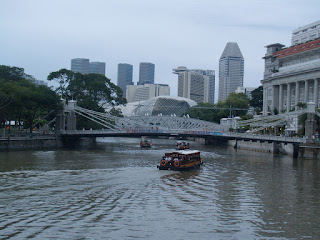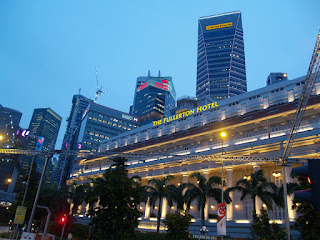Singapore's name comes from "Singa Pura " or Lion City, a name that arose during the century XI and which has roots in the legend that a prince who visited the area saw an animal he mistook for a lion.
Singapore is one of those places that appeals to almost everyone. For various reasons and you look at a city-state is unusual in the chaos that exists in other Southeast Asian countries. So much so that at times had the feeling of walking through a theme park. Not in Little India or Chinatown or Kampong Glam (Muslim Quarter) I add up the extreme cleanliness, order or good signs.
Although it may seem otherwise, Singapore is not a mount for tourists, but most visitors feel comfortable. Some choose it as an exotic but safe, without having to take risks of any kind; enjoy its luxury hotels, a rich gastronomy, or their well-stocked shops. Others use it as a break or a short break before or after a trip to other countries in Southeast Asia.
Singapore is a country of immigrants, especially Chinese, Indians and Malays who have adapted to the strict rules of civility imposed by the government, without losing the essence of his country of origin. And all this in perfect harmony sharing a small piece of land where skyscrapers take much of the role.
The Singapore skyline disappointed me a little, perhaps why a few months before had been in Hong Kong, an impressive city and so far, which ranks number one on my list skylines particular, by ahead of New York, Tokyo and Kuala Lumpur.
said, should not detract in any way to Singapore, because its charm is undeniable.
After spending nearly three weeks in Borneo we wanted to finish the trip in Singapore, in a first contact with the Lion City.
The guided tour of the city is pleasant and comfortable. Points of interest are quite close to each other and can easily go on foot. If you have to take a means of transportation, the subway is undeniably better, faster, cheaper and cleanliness ... and the whole city. And this has been achieved based on staff fined for something is known as "The fine city" City or fines. Nearly five million people are crammed into less than 700 kilometers square and despite the high population density, order and cleanliness is not just a myth. Some of the rules have a certain purpose, although some are a little absurd. Violating certain rules as a ban on chewing gum, to obstruct the passage of throwing papers, eating and drinking on the metro, cross the street outside the pedestrian crossings and smoking supuestísimo ... among others, is of fine. Some other prohibitions beyond, since homosexuality is paid with 10 years in prison and drug trafficking is punishable by death.
This series of prohibitions draw attention to visitors, but Singaporeans have managed to find the positive part making up a good collection of souvenirs (shirts, postcards, pens, magnets ...) with the sign of prohibition and the amount of the fine. Anyway I must say that a paper on the floor yeah we saw (was it the work of some clueless tourist ") and that some of the most absurd bans chewing gum as I get the feeling that it is a thing of the past.
So, we spent three days to meet their most historic and enjoy the great atmosphere.
Singapore River Quays:
The first impression of the city was very good. It appears as an elegant city, with magnificent colonial buildings and well kept, manicured lawns, beautiful sculptures that recall the commercial origin of the port of Singapore. In short, a modern and clean city with great atmosphere.
Here, the Singapore River reaches the bay known as Marina Bay . Some lofty skyscrapers to compete with the white colonial buildings transport us to another era, when Singapore was part of the British Crown.
One of these buildings is the elegant Fullerton hotel, situated in the old post office building and rehabilitated for such use. When it gets dark and thousands of lights are appearing as if by magic, the scene changes completely.
Merlion Park Since there are amazing views of the Esplanade Park , the modern skyscrapers of Marina Bay and the Giant Ferris Wheel. Here is the famous fountain (and indeed, quite ugly) with the statue symbol of the city: the lion fish's body.
In Boat Quay is a vast number of pubs and nightlife spots in the beginning, along with seafood restaurants next to each other. Walking around the dinner becomes an obstacle course and each establishment has a "fisherman" trying to convince the potential client base. Prices are not low but the temptation overcomes us and place and convinces us our first night we had dinner overlooking the Singapore River.
Little India and Kampong Glam:
Moving around the different ethnic neighborhoods Singapore is like reading a comprehensive introduction on the Asian continent.
Serangoon Road is the main artery of Little India . This was an area where buffalo were brought up (hence the name of Buffalo Road) and where relevant were also slaughterhouses. The neighborhood was growing and is currently a small portion of India brought here: the colors of the Sharis, the smell of incense and spices, Bollywood music playing in the interior of the stores, small flower lei stands, temples, billboards, the colorful facades of shophouses ... Almost every house has a business on the ground floor, either a shop, a shop, a tailoring ... and the owners live upstairs.
are many aspects reminiscent of India, but the cleanliness of its streets and each of its corners, the lack of traffic chaos, amid cow of the road and mountains of garbage, make the biggest differences with the country of origin. We visited two of the most important Hindu temples in the city, whose unpronounceable names are impossible to learn: The Sri Veeramakaliamman which is dedicated to Kali, the consort of Siva the destroyer and Sri Srinivasa Perumal , dedicated to Vishnu. The activity developed in Hindu temples always I was fascinated, especially in the early hours of the morning is a swarm of people coming and going. The faithful bring offerings of fruit and milk of tetrabrick passes some large containers for such use. The priests, in turn, shared blessings and anointing to those who come to worship their gods, whether the goddess Kali, Ganesh - the elephant god Kali and Siva's son - or anyone else, because they exist for all tastes.
El ajetreo de estos dos templos contrasta con la quietud que se respira en el templo budista de Sakaya Muni Buddha o templo de las Mil Luces, en el cual se encuentra un gran buda de 15 metros y 300 toneladas cuya plácida sonrisa contagia más aun esta sensación de paz o en el templo taoista de Leong San See , justo enfrente del anterior.
Siguiendo las indicaciones sobre el mapa vamos cortando calles hasta llegar to the Arab Street that leads to Kampong Glam, the Malay or Muslim neighborhood of the city. Its name derives from the word "people" in Malay (Kampung) and gelam, a tree that grew in this place. Among the colorful shophouses stands the imposing dome of the Sultan Mosque, the largest in Singapore. We wear shorts and not even try to enter the interior, we settle for admiring the beautiful golden dome from different angles. Street Busorah Street is the most concentrated commercial and tourist activity. It is a picturesque lane with palm trees on both sides that lead to the entrance of the mosque.
Without having to walk too much, change of scenery as well as time and immerse ourselves in the nineteenth century . We are in the colonial district where colorful gopuram (Hindu temple towers) and shophouses are replaced by buildings with white facades that transport us to the years when the British controlled these lands. Perhaps the best example of that time is the Raffles Hotel which is named for Sir Thomas Stamford Raffles, who landed in Singapore in 1819. Behind the immaculate white walls lies a world in itself: luxury brand shops, restaurants and beautiful gardens of lush vegetation where, legend or fact, is said to be killed here last tiger in Singapore.
Leaving the nineteenth century and the twenty-first century arrived with one of the most representative buildings of modern Singapore: Esplanade - Theatres on the Bay , consisting of two semi domes are gilded resemble a durian as some or a fly's eyes, according to others. Inside is a large cultural and leisure offer from theaters, concert halls, exhibitions and how could it be otherwise, more shops and more restaurants. The interesting thing is up to the terrace where you can enjoy a magnificent view of Marina Bay, Singapore where the river meets the sea, Merlion Park and the skyscrapers of the financial district.
intuit much in Clark Quay entertainment we return later on foot. This area just a few years ago was neglected and forsaken of God, has become an area where the greatest number of pubs, bars and restaurants throughout the city, of all styles for all tastes .
River bridges is completely "Occupied" by the Singapore Gastronomic . During the month of July of each year marks this event where locals and visitors can enjoy and participate in the popular hobby of Singaporeans: eating.
The entire bridge surface is covered with large carp and is concentrated inside a crowd of onlookers and people interested in tasting the different delicacies to an affordable price. On both sides happen a number of food stalls where they serve all sorts of delights for the palate: dim-sum, spring rolls, rice and noodles cooked in several ways, lacquered duck ... and sweets, including different specialties with durian, smelly fruit but who knows.
In the center, they have some large tables where people share while going pecking, drinking and having a great time.
Chinatown:
Anyone traveling to Singapore either Chinatown should overlook. We went underground through the picturesque streets Pagoda St. The red fanalillos and the predominance of color that indicate that we are right in Chinatown, however, the facades of the houses are on the same lines and other districts like Little India and Kampong Glam are painted with different colors . Many souvenir shops, clothing at reasonable prices, Chinese lacquers, and many food stalls. Interestingly, the oldest Hindu temple in the city, the Sri Mariamman Temple , built in 1823, stands in the heart of Chinatown. The gopuram is superb and the images of Brahma, Vishnu and Shiva share the limelight with sculptures holy cow that cover the wall that closes the exhibition. The temple has been renovated recently and the colors look especially vivid and intense. Although some devotees, breathe the bustle of the temples visited Little India, home to the majority of people who profess the Hindu religion.
Our last shot before leaving for the airport what we spend on Orchard Road . This glamorous street was compared to the Champs Elysees in Paris, Manhattan's Fifth Avenue or Oxford Street in London, but I find that even exceeds in some respects. Modern design malls and storefronts that compete in elegance, in Orchard Road is leading the way in fashion and living the dynamism of this cosmopolitan city.



























































0 comments:
Post a Comment